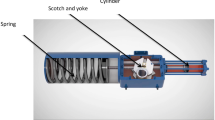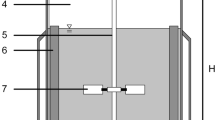Abstract
In order to monitor the condition of patients with implantable left ventricular assist systems (LVAS), it is important to measure pump flow rate continuously and noninvasively. However, it is difficult to measure the pump flow rate, especially in an implantable axial flow blood pump, because the power consumption has neither linearity nor uniqueness with regard to the pump flow rate. In this study, a miniaturized mass-flow meter for discharged patients with an implantable axial blood pump was developed on the basis of computational analysis, and was evaluated in in-vitro tests. The mass-flow meter makes use of centrifugal force produced by the mass-flow rate around a curved cannula. An optimized design was investigated by use of computational fluid dynamics (CFD) analysis. On the basis of the computational analysis, a miniaturized mass-flow meter made of titanium alloy was developed. A strain gauge was adopted as a sensor element. The first strain gauge, attached to the curved area, measured both static pressure and centrifugal force. The second strain gauge, attached to the straight area, measured static pressure. By subtracting the output of the second strain gauge from the output of the first strain gauge, the mass-flow rate was determined. In in-vitro tests using a model circulation loop, the mass-flow meter was compared with a conventional flow meter. Measurement error was less than ±0.5 L/min and average time delay was 0.14 s. We confirmed that the miniaturized mass-flow meter could accurately measure the mass-flow rate continuously and noninvasively.











Similar content being viewed by others
References
Hoshi H, Shinshi T, Takatani S. Third generation blood pumps with mechanical non-contact magnetic bearing. Artif Organs. 2006;30:324–39.
Nojiri C, Kijima T, Maekawa J, Horiuchi K, Kido T, Sugiyama T, Mori T, Sugiura N, Asada T, Ozaki T, Suzuki M, Akamatsu T, Akutsu T. Development of Terumo implantable left ventricular assist system (T-ILVAS) with a magnetically suspended centrifugal pump. J Artif Organs. 1999;2:3–7.
LaRose JA, Gore BG, Indravudh V, Frazier OH. Heartware—A novel miniaturized passive maglev centrifugal Vad. ASAIO J Abstr. 2004;50:137.
Wampler R, Lancisi D, Indravudh V, Gauthier R, Fine R. A sealless centrifugal blood pump with passive magnetic and hydrodynamic bearings. Artif Organs. 1999;23:780–4.
Takatani S, Matsuda H, Hanatani A, Nojiri C, Yamazaki K, Motomura T, Ohuchi K, Sakamoto T, Yamane T. Mechanical circulatory support devices (MCSD) in Japan: current status and future directions. J Artif Organs. 2005;8:13–25.
Yaname T. The present and future state of nonpulsatile artificial heart technology. J Artif Organs. 2002;5:149–55.
Yamagishi H, Sankai Y, Yamane T, Jikuya T, Tsutsui T. Development of built-in type and noninvasive sensor systems for smart artificial heart. ASAIO J. 2003;49:265–70.
Tanaka A, Yoshizawa M, Abe K, Takeda H, Yambe T, Nitta S. In vivo test of pressure head and flow estimation in a continuous-flow artificial heart. Artif Organs. 2003;27:99–103.
Tsukiya T, Akamatsu T, Nishimura K, Yamada T, Nakazeki T. Use of motor current in flow rate measurement for the magnetically suspended centrifugal blood pump. Artif Organs. 1997;21:396–401.
Funakubo A, Ahmed S, Sakuma I, Fukui Y. Flow rate and pressure head estimation in a centrifugal blood pump. Artif Organs. 2002;26:985–90.
Stepanoff AJ. Centrifugal and axial flow pumps. New York: Wiley; 1948.
Kano K, Mitamura Y. Why is estimation of flow difficult in an axial flow pump? Abstract of International Society for Rotary Blood Pumps. 2008:5.
Pai CN, Shinshi T, Shimokohbe A. Sensorless measurement of pulsatile flow rate using a disturbance force observer in a magnetically levitated centrifugal blood pump during ventricular assistance. Flow Meas Instrum. 2010;21:33–9.
Masuzawa T, Kita T, Okada Y. An ultradurable and compact rotary blood pump with a magnetically suspended impeller in the radial direction. Artif Organs. 2001;25:395–9.
Griffith BP, Kormos RL, Borovetz HS, Litwak K, Antaki JF, Poirier VL, Butler KC. HeartMate II left ventricular assist system: from concept to first clinical use. Ann Thoracic Surg. 2001;71:116–20.
Wieselthaler GM, Schima H, Hiesmayr M, Pacher R, Laufer G, Noon GP, DeBakey M, Wolner E. First clinical experience with the DeBakey VAD continuous-axial-flow pump for bridge to transplantation. Circulation. 2000;101:356–9.
Tsukiya T. Evaluation of the axial flow pump ventricular assist device by the chronic animal experiments. Abstract of International Society for Rotary Blood Pumps. 2009:148.
Kosaka R, Maruyama O, Nishida M, Saito S, Hirai S, Yamane T. Improvement of hemocompatibility in a centrifugal blood pump with hydrodynamic bearings and a semi-open Impeller. Artif Organs. 2009;33:798–804.
Acknowledgments
This study was supported in part by the Industrial Technology Research Grant Program in 2009 from the New Energy and Industrial Technology Development Organization (NEDO) of Japan, and by a Grant-in-Aid for Scientific Research (KAKENHI).
Author information
Authors and Affiliations
Corresponding author
Rights and permissions
About this article
Cite this article
Kosaka, R., Nishida, M., Maruyama, O. et al. Development of a miniaturized mass-flow meter for an axial flow blood pump based on computational analysis. J Artif Organs 14, 178–184 (2011). https://doi.org/10.1007/s10047-011-0569-5
Received:
Accepted:
Published:
Issue Date:
DOI: https://doi.org/10.1007/s10047-011-0569-5




